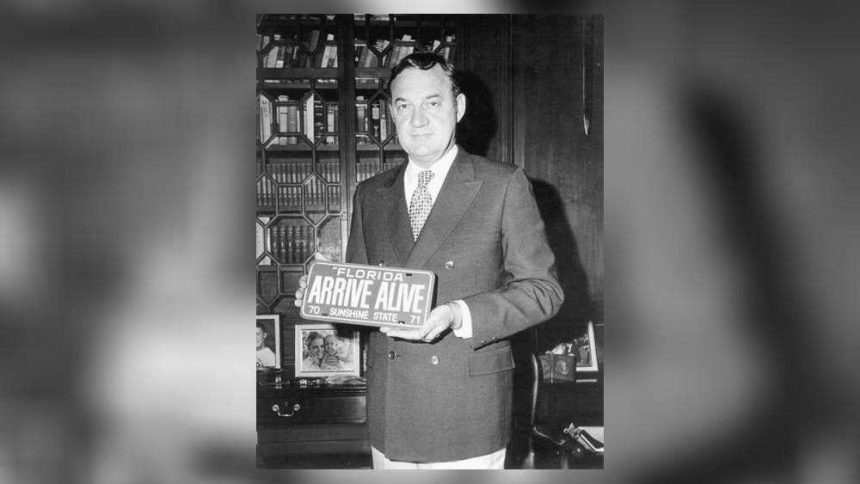Editor’s note: This story first ran in Eliot Kleinberg’s Florida Time column in July 2019.
Between 1938 and 1975, Florida assigned each of its 67 counties a number that was based on its population rank in the 1935 census. That number was integral to the state’s license plate numbering system. Over the years, counties fluctuated in size, but the numbers stayed untouched.
Here were the top 10:
-
4. Pinellas (St. Petersburg)
-
8. Volusia (Daytona Beach)
-
10. Broward (Fort Lauderdale)
Former Gov. Claude Kirk displays a vanity automobile license plate in 1970.
Also: Alachua (Gators) was 11. Leon (Seminoles) was 13. Adjacent Manatee and Sarasota were 15 and 16, respectively. St. Johns, one of the first two counties historically, was 20. Monroe (the Keys) was 38. Tiny Liberty, in the Panhandle, was 67.
A 90 on the plate indicated a duplicate, replacing a lost or stolen one. A 68 meant you got your tag at the state agency in Tallahassee.
Here’s some more on the history of license plates:
In 1905, the state required car owners to register their vehicles and issued paper certificates to be displayed on the vehicle. The first plate, made of leather, was issued in 1906. It went to metal in 1910, porcelain in 1912 and tin in 1918. Plates became the responsibility of counties in 1911. The state took over registration in 1917, giving everyone two plates. That was reduced to one plate in 1922. During the Depression, stealing plates was common because people couldn’t afford them.
“Sunshine State” first appeared in 1949. A grapefruit in a corner, done in 1935, lasted only a year; it looked too much like a bomb.
“Disabled veteran” started in 1951. That same year, a “Keep Florida Green” slogan was tried; it lasted only a year because some said it sounded like the state wanted all the tourists’ money.
In 1957, “Horseless Carriage” was adopted for vehicles whose bodies and engine — not just kits — were at least 35 years old and which were driven for historical exhibitions. The 1965 tag marked the 400th anniversary of the first European encounter with Florida. “National Guard” was added that year as well. A wheelchair plate was added in 1974.

Florida has many specialty plates to choose from.
Beginning in 1963, tags were required for mobile homes, house trailers and campers.
In 1972, the state began allowing people to pick their own “vanity plate” number-letter combination for a $12 surcharge. In 1975, to cut costs, the state began issuing renewal decals instead of all-new plates. In 1978, Florida went to a mandatory alphanumeric system to allow for more combinations.
In the 1980s and 1990s, the state began adding notations such as “U.S. Reserve,” “Ex-POW,” “Pearl Harbor Survivor” and “Medal of Honor.” The first specialty plate, to honor the Challenger astronauts, was issued in 1987. State universities followed that same year and private ones after that. The state also added such specialty plates as “Save the Manatee,” “Florida Panther” and “Choose Life,” which encourages adoption.
Seminole and Miccosukee motorists get free license plates, which are issued directly by tag agencies of the two tribes.

Sen. Gayle Harrel, R- Jupiter, smiles and holds the Jimmy Buffet specialty license plate prototype inside the Florida Capitol, Jan. 25, 2024.
Eliot Kleinberg is a former staff writer for The Palm Beach Post and the author of numerous books about Florida and its history.
This article originally appeared on Palm Beach Post: The history of the Florida license plate, from 1905 to present









